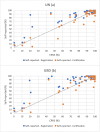How reliable are self-reported estimates of birth registration completeness? Comparison with vital statistics systems
- PMID: 34101745
- PMCID: PMC8186773
- DOI: 10.1371/journal.pone.0252140
How reliable are self-reported estimates of birth registration completeness? Comparison with vital statistics systems
Abstract
Background: The widely-used estimates of completeness of birth registration collected by Demographic and Health Surveys (DHS) and Multiple Indicator Cluster Surveys (MICS) and published by UNICEF primarily rely on registration status of children as reported by respondents. However, these self-reported estimates may be inaccurate when compared with completeness as assessed from nationally-reported official birth registration statistics, for several reasons, including over-reporting of registration due to concern about penalties for non-registration. This study assesses the concordance of self-reported birth registration and certification completeness with completeness calculated from civil registration and vital statistics (CRVS) systems data for 57 countries.
Methods: Self-reported estimates of birth registration and certification completeness, at ages less than five years and 12-23 months, were compiled and calculated from the UNICEF birth registration database, DHS and MICS. CRVS birth registration completeness was calculated as birth registrations reported by a national authority divided by estimates of live births published in the United Nations (UN) World Population Prospects or the Global Burden of Disease (GBD) Study. Summary measures of concordance were used to compare completeness estimates.
Findings: Birth registration completeness (based on ages less than five years) calculated from self-reported data is higher than that estimated from CRVS data in most of the 57 countries (31 countries according to UN estimated births, average six percentage points (p.p.) higher; 43 countries according to GBD, average eight p.p. higher). For countries with CRVS completeness less than 95%, self-reported completeness was higher in 26 of 28 countries, an average 13 p.p. and median 9-10 p.p. higher. Self-reported completeness is at least 30 p.p. higher than CRVS completeness in three countries. Self-reported birth certification completeness exhibits closer concordance with CRVS completeness. Similar results are found for self-reported completeness at 12-23 months.
Conclusions: These findings suggest that self-reported completeness figures over-estimate completeness when compared with CRVS data, especially at lower levels of completeness, partly due to over-reporting of registration by respondents. Estimates published by UNICEF should be viewed cautiously, especially given their wide usage.
Conflict of interest statement
The authors have declared that no competing interests exist.
Figures
Similar articles
-
Global analysis of birth statistics from civil registration and vital statistics systems.Bull World Health Organ. 2023 Dec 1;101(12):768-776. doi: 10.2471/BLT.22.289035. Epub 2023 Nov 2. Bull World Health Organ. 2023. PMID: 38024250 Free PMC article.
-
Who and where are the uncounted children? Inequalities in birth certificate coverage among children under five years in 94 countries using nationally representative household surveys.Int J Equity Health. 2017 Aug 18;16(1):148. doi: 10.1186/s12939-017-0635-6. Int J Equity Health. 2017. PMID: 28821291 Free PMC article.
-
Estimating completeness of birth registration in South Africa, 1996 - 2011.Bull World Health Organ. 2019 Jul 1;97(7):468-476. doi: 10.2471/BLT.18.222620. Epub 2019 May 28. Bull World Health Organ. 2019. PMID: 31258216 Free PMC article.
-
A multisectoral institutional arrangements approach to integrating civil registration, vital statistics, and identity management systems.J Health Popul Nutr. 2019 Oct 18;38(Suppl 1):19. doi: 10.1186/s41043-019-0179-z. J Health Popul Nutr. 2019. PMID: 31627747 Free PMC article. Review.
-
Towards universal civil registration and vital statistics systems: the time is now.Lancet. 2015 Oct 3;386(10001):1407-1418. doi: 10.1016/S0140-6736(15)60170-2. Epub 2015 May 10. Lancet. 2015. PMID: 25971217 Review.
Cited by
-
Global analysis of birth statistics from civil registration and vital statistics systems.Bull World Health Organ. 2023 Dec 1;101(12):768-776. doi: 10.2471/BLT.22.289035. Epub 2023 Nov 2. Bull World Health Organ. 2023. PMID: 38024250 Free PMC article.
-
Household and context-level determinants of birth registration in Sub-Saharan Africa.PLoS One. 2022 Apr 8;17(4):e0265882. doi: 10.1371/journal.pone.0265882. eCollection 2022. PLoS One. 2022. PMID: 35395001 Free PMC article.
-
Incompleteness and Misclassification of Maternal Deaths in Zimbabwe: Data from Two Reproductive Age Mortality Surveys, 2007-2008 and 2018-2019.J Epidemiol Glob Health. 2024 Dec;14(4):1642-1649. doi: 10.1007/s44197-024-00318-1. Epub 2024 Nov 12. J Epidemiol Glob Health. 2024. PMID: 39531181 Free PMC article.
-
Health sector leadership to strengthen civil registration and vital statistics systems.Bull World Health Organ. 2023 Dec 1;101(12):751-751A. doi: 10.2471/BLT.22.289038. Bull World Health Organ. 2023. PMID: 38046367 Free PMC article. No abstract available.
References
-
- Todres J. Birth registration: An essential first step toward ensuring the rights of all children. Human Rights Brief. 2003;10:32–5.
-
- UNICEF. Birth registration: a right from the start. Florence: UNICEF; 2002.
-
- Health Metrics Network. Strengthening civil registration and vital statistics for births, deaths and causes of death: Resource Kit. Geneva; 2013.
-
- Szreter S. The right of registration: Development, identity registration, and social security—A historical perspective. World Dev. 2007;35(1):67–86.
Publication types
MeSH terms
LinkOut - more resources
Full Text Sources


